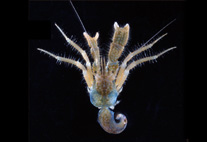Abstract
Larval morphology and substrate-borne vibrational courtship songs have been hypothesized to distinguish and isolate Chrysoperla ‘nipponensis-B’ from true ‘Type A’ Chrysoperla nipponensis (Okamoto), both of which occur sympatrically in eastern Asia. Here, we formally describe C. ‘nipponensis-B’ as Chrysoperla nigrocapitata sp.n., based on populations sampled throughout Japan and at two sites in South Korea. Behavioral playback experiments show that males and females of each species reject the duetting songs of non-conspecifics, supporting the existence in nature of strong premating reproductive isolation between the two species. Detailed morphological analysis substantiates that the adults of the two species are nearly identical. However, the dorsum of the larval head of C. nigrocapitata is usually darkly and heavily pigmented, in striking contrast to the condition seen in C. nipponensis; if available, it is probably the best trait for distinguishing the two species morphologically. Other aspects of life history, ecology, geographic distribution, and molecular systematics of the new species are briefly considered.

